Bicycle


The bicycle, bike, or cycle, is a pedal-driven, human-powered vehicle with two wheels attached to a frame, one behind the other.
First introduced in 19th-century Europe, bicycles now number approximately one billion worldwide,[1] providing the principal means of transportation in many regions, notably China and the Netherlands[citation needed]. They also provide a popular form of recreation, and have been adapted for use in many other fields of human activity, including children's toys, adult fitness, military and police applications, courier services, and cycle sports.
The basic shape and configuration of a typical bicycle has hardly changed since the first chain-driven model was developed around 1885,[2] although many important details have been improved, especially since the advent of modern materials and computer-aided design. These have allowed for a proliferation of specialized designs for particular types of cycling.
The bicycle has affected history considerably, in both the cultural and industrial realms. In its early years, bicycle construction drew on pre-existing technologies; more recently, bicycle technology has, in turn, contributed ideas in both old and newer areas.
History
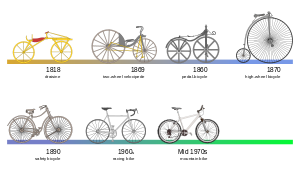

Several innovators contributed to the history of the bicycle by developing precursor human-powered vehicles, including the velocipede, invented in 1763 in France by Pierre Lallement. The documented ancestors of today's modern bicycle were known as pushbikes, Draisines or hobby horses. To use the Draisine, first introduced to the public in Paris by the German Baron Karl von Drais in 1818[3], the operator sat astride a wooden frame supported by two in-line wheels and pushed the vehicle along with his/her feet while steering the front wheel.

Scottish blacksmith Kirkpatrick MacMillan refined this in 1839 by adding a mechanical crank drive to the rear wheel, thus creating the first true "bicycle" in the modern sense. In the 1850s and 1860s, Frenchmen Pierre Michaux and Pierre Lallement took bicycle design in a different direction, placing the pedals on an enlarged front wheel. Their creation, of wrought iron and wood, developed into the "penny-farthing" (more formally an ordinary bicycle), featuring a tubular steel frame on which were mounted wire spoked wheels with solid rubber tires. These bicycles were not, however, for the faint hearted, due to the very high seat and poor weight distribution.
The subsequent dwarf ordinary addressed some of these faults by reducing the front wheel diameter and setting the seat further back, necessitating the addition of gearing, effected in a variety of ways, to attain sufficient speed. However, having to both pedal and steer via the front wheel remained a problem. Starley's nephew, J. K. Starley, J. H. Lawson, and Shergold solved this problem by introducing the chain drive connecting the pedals held with the frame to the back wheel. These models were known as dwarf safeties, or safety bicycles, for their lower seat height and better weight distribution. Starley's 1885 Rover is usually described as the first recognizably modern bicycle. Soon, the seat tube was added, creating the double-triangle diamond frame of the modern bike.

New innovations increased comfort, and ushered in a second bicycle craze, the 1890s' Golden Age of Bicycles. In 1888, Scotsman John Boyd Dunlop introduced the pneumatic tire, which soon became universal. Soon after, the rear freewheel was developed, enabling the rider to coast without the pedals spinning out of control. This refinement led to the 1898 invention of coaster brakes. Derailleur gears and hand-operated cable-pull brakes were also developed during these years, but were only slowly adopted by casual riders. By the turn of the century, cycling clubs flourished on both sides of the Atlantic, and touring and racing were soon extremely popular.
Bicycles and horse buggies were the two mainstays of private transportation just prior to the automobile, and the grading of smooth roads in the late 19th century was stimulated by the wide use of these devices.
Technical aspects
Legal requirements


The 1968 Vienna Convention on Road Traffic of the United Nations considers a bicycle to be a vehicle, and a person controlling a bicycle is considered a driver. The traffic codes of many countries reflect these definitions and demand that a bicycle satisfy certain legal requirements, sometimes even including licensing, before it can be used on public roads. In many jurisdictions it is an offence to use a bicycle that is not in roadworthy condition. In most places when ridden after dark, bicycles must have functioning front and rear lights, or "lamps". As some generator or dynamo-driven lamps only operate while moving, rear reflectors are frequently also mandatory. Since a moving bicycle makes little noise, some countries insist that bicycles have a warning bell for use when approaching pedestrians, equestrians and other bicyclists.
Standards
A number of formal and industry standards exist for bicycle components, to help make spare parts exchangeable:
- ISO 5775 Bicycle tire and rim designations
- ISO 8090 Cycles — Terminology (same as BS 6102-4)
- ISO 4210 Cycles — Safety requirements for bicycles
Construction and parts
Wheels
Frame
Nearly all modern upright bicycles feature the diamond frame, a truss, consisting of two triangles: the front triangle and the rear triangle. The front triangle consists of the head tube, top tube, down tube and seat tube. The head tube contains the headset, the set of bearings that allows the fork to turn smoothly for steering and balance. The top tube connects the tube to the seat tube at the top, and the down tube connects the head tube to the bottom bracket. The rear triangle consists of the seat tube and paired chain stays and seat stays. The chain stays run parallel to the chain, connecting the bottom bracket to the rear dropouts. The seat stays connect the top of the seat tube (at or near the same point as the top tube) to the rear dropouts.
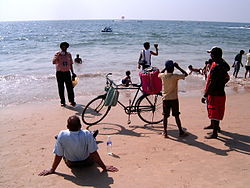
Historically, women's bicycle frames had a top tube that connected in the middle of the seat tube instead of the top, resulting in a lower standover height at the expense of compromised structural integrity, since this places a strong bending load in the seat tube, and bicycle frame members are typically weak in bending. This design, referred to as a step-through frame, purportedly allows the rider to mount and dismount in a dignified way while wearing a skirt or dress. While some women's bicycles continue to use this frame style, there is also a variation, the mixte, which splits the top tube into two small top tubes that bypass the seat tube and connect to the rear dropouts. The ease of stepping through is also appreciated by those with limited flexibility or other joint problems. Because of its persistent image as a "women's" bicycle, step-through frames are not common for larger builds.
Historically, materials used in bicycles have followed a similar pattern as in aircraft, the goal being high strength and low weight. Since the late 1930s alloy steels have been used for frame and fork tubes in higher quality machines. Celluloid found application in mudguards, and aluminium alloys are increasingly used in components such as handlebars, seat post, and brake levers. In the 1980s aluminium alloy frames became popular, and their affordability now makes them common. More expensive carbon fiber and titanium frames are now also available, as well as advanced steel alloys.
Drivetrain
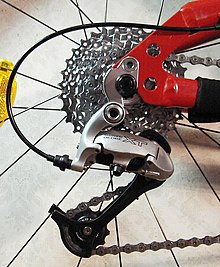
The drivetrain begins with pedals which rotate the crank arms, which are held in axis by the bottom bracket. Attached to one crank arm may be one or more chainrings or sprockets which drive the chain, which in turn rotates the rear wheel via the rear sprockets (cassette or freewheel). A gearing system is used to vary the number of rear wheel revolutions produced by each turn of the pedals.
Since cyclists' legs are most efficient over a narrow range of cadences, a variable gear ratio is helpful to maintain an optimum pedalling speed while covering varied terrain.
When the bicycle chain shifts to a larger rear sprocket, or to a smaller front sprocket (a lower gear) every turn of the pedal leads to fewer rotations in the freewheel (and hence the rear wheel). This allows the force required to move the same distance to be distributed over more pedal cycles, reducing fatigue when riding uphill, with a heavy load, or against strong winds. The reverse process allows the cyclist to make fewer pedal cycles to maintain a higher speed, but with more effort per cycle.
Road bicycles have close set multi-step gearing, which allows fine control of cadence, while utility bicycles offer fewer, more widely spaced speeds. Mountain bikes, touring bikes and many entry-level racing bicycles offer an extremely low gear to facilitate climbing slowly on steep hills. Single-speed bicycles have only one gear combination.
Steering and seating
The handlebars turn the fork and the front wheel via the stem, which rotates within the headset. Three styles of handlebar are common. Upright handlebars, the norm in Europe and elsewhere until the 1970s, curve gently back toward the rider, offering a natural grip and comfortable upright position. Drop handlebars are "dropped", offering the cyclist either an aerodynamic "crouched" position or a more upright posture in which the hands grip the brake lever mounts. Mountain bikes feature a straight handlebar which can provide better low-speed handling due to the wider nature of the bars.
Saddles also vary with rider preference, from the cushioned ones favoured by short-distance riders to narrower saddles which allow more room for leg swings. Comfort depends on riding position. With comfort bikes and hybrids the cyclist sits high over the seat, their weight directed down onto the saddle, such that a wider and more cushioned saddle is preferable. For racing bikes where the rider is bent over, weight is more evenly distributed between the handlebars and saddle, and the hips are flexed, and a narrower and harder saddle is more efficient. Differing saddle designs exist for male and female cyclists, accommodating the genders' differing anatomy, although bikes typically are sold with saddles most appropriate for males.
A recumbent bicycle has a reclined chair-like seat that some riders find more comfortable than a saddle, especially riders who suffer from certain types of seat, back, neck, shoulder, or wrist pain. Recumbent bicycles may have either under-seat or over-seat steering.
Brakes

Modern bicycle brakes are either rim brakes, in which friction pads are compressed against the wheel rims, internal hub brakes, in which the friction pads are contained within the wheel hubs, or disc brakes. Disc brakes are common on off-road bicycles, tandems and recumbent bicycles, but are considered impractical on road bicycles, which rarely encounter conditions where the advantages of discs are significant. Hub drum brakes do not cope well with extended braking, so rim or disc brakes are favoured in hilly terrain.
With hand-operated brakes, force is applied to brake levers mounted on the handlebars and transmitted via Bowden cables or hydraulic lines to the friction pads. A rear hub brake may be either hand-operated or pedal-actuated, as in the back pedal coaster brakes which were popular in North America until the 1960s, and are still common in children's bicycles.
Track bicycles do not have brakes. Brakes are not required for riding on a track because all riders ride in the same direction around a track which does not necessitate sharp deceleration. Track riders are still able to slow down because all track bicycles are fixed-gear, meaning that there is no freewheel. Without a freewheel, coasting is impossible, so when the rear wheel is moving, the crank is moving. To slow down one may apply resistance to the pedals. While it is illegal in most jurisdictions to cycle on roads without brakes, a fixed-gear bike without brakes can be slowed by skidding the rear wheel. This involves unweighting the rear wheel and applying a backwards force to the pedals, causing the rear wheel to lock up and slide along the road. Most track bike frames and forks do not have holes for mounting brakes, although with their increasing popularity among some road cyclists, some manufacturers have designed their track frames to enable the fitting of brakes.
Suspension
Bicycle suspension refers to the system or systems used to suspend the rider and all or part of the bicycle in order to protect them from the roughness of the terrain over which they travel. Bicycle suspension are used primarily on mountain bicycles, but are also common on hybrid bicycles, and can even be found on some road bicycles as they can help deal with problematic vibration.
Accessories and repairs
Some components, which are often optional accessories on sports bicycles, are standard features on utility bicycles to enhance their usefulness and comfort. Mudguards (or fenders) protect the cyclist and moving parts from spray when riding through wet areas and chainguards protect clothes from oil on the chain. Kick stands keep a bicycle upright when parked. Front-mounted baskets for carrying goods are often used. Rear racks and panniers or other carriers can be used to carry equipment or cargo. Parents sometimes add rear-mounted child seats and/or an auxiliary saddle fitted to the crossbar to transport children.
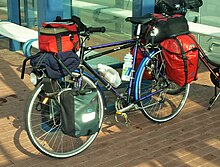
Toe-clips and toestraps and clipless pedals help to keep the foot planted firmly in the proper position on the pedals, and enable the cyclist to pull as well as push the pedals. Technical accessories include cyclocomputers for measuring speed and distance. Other accessories include lights, reflectors, tire pump, security lock, mirror, and bell.[4]
Bicycle helmets may help reduce injury in the event of a collision or accident, and a certified helmet is legally required for some riders in some jurisdictions. Helmets are classified as an accessory[4] or an item of clothing by others.[5]
Many cyclists carry tool kits. At the least this will include a tire patch kit (these contain tube-patching material, an adhesive, a block of French chalk and a metal grater to reduce the chalk to power) and/or a spare tube, tire levers, and hex wrenches. More specialised parts now require more complex tools, including proprietary tools specific for a given manufacturer. Some bicycle parts, particularly hub-based gearing systems, are complex, and many prefer to leave maintenance and repairs to professional bicycle mechanics. Others maintain their own bicycles, enhancing their enjoyment of the hobby of cycling.
In some areas it is possible to purchase road-side assistance from companies such as the Better World Club.
Performance

In both biological and mechanical terms, the bicycle is extraordinarily efficient. In terms of the amount of energy a person must expend to travel a given distance, investigators have calculated it to be the most efficient self-powered means of transportation.[6] From a mechanical viewpoint, up to 99% of the energy delivered by the rider into the pedals is transmitted to the wheels, although the use of gearing mechanisms may reduce this by 10-15%.[7][8] In terms of the ratio of cargo weight a bicycle can carry to total weight, it is also a most efficient means of cargo transportation.
A human being travelling on a bicycle at low to medium speeds of around 10-15 mph (15-25 km/h), using only the energy required to walk, is the most energy-efficient means of transport generally available. Air drag, which increases with the square of speed, requires dramatically higher power outputs with increasing speed. A bicycle which places the rider in a seated position, supine position or, more rarely, prone position, and which may be covered in an aerodynamic fairing to achieve very low air drag, is referred to as a recumbent bicycle or human powered vehicle. On an upright bicycle, the rider's body creates about 75% of the total drag of the bicycle/rider combination.
In addition, the carbon dioxide generated in the production and transportation of the food required by the bicyclist, per mile traveled, is less than 1/10th that generated by energy efficient cars.[9]
Dynamics

A bicycle stays upright by being steered so as to keep its centre of gravity over its wheels. This steering is usually provided by the rider, but under certain conditions may be provided by the bicycle itself.
A bicycle must lean in order to turn. This lean is induced by a method known as countersteering, which can be performed by the rider turning the handlebars directly with the hands or indirectly by leaning the bicycle.
Short-wheelbase or tall bicycles, when braking, can generate enough stopping force at the front wheel in order to flip longitudinally. This action, especially if performed on purpose, is known as a stoppie, endo or front wheelie.
Further reading
For more information on the technical aspects of bicycles, see also:
Social and historical aspects

Economic implications
Bicycle manufacturing proved to be a training ground for other industries and led to the development of advanced metalworking techniques, both for the frames themselves and for special components such as ball bearings, washers, and sprockets. These techniques later enabled skilled metalworkers and mechanics to develop the components used in early automobiles and aircraft. J. K. Starley's company became the Rover Cycle Company Ltd. in the late 1890s, and then the Rover auto maker. The Morris Motor Company (in Oxford) and Škoda also began in the bicycle business, as did the Wright Brothers.[10]
In general, U.S. and European cycle manufacturers used to assemble cycles from their own frames and components made by other companies, although very large companies (such as Raleigh) used to make almost every part of a bicycle (including bottom brackets, axles, etc.) In recent years, those bicycle makers have greatly changed their methods of production. Now, almost none of them produce their own frames. Many newer or smaller companies only design and market their products; the actual production is done by Asian companies. For example, some sixty percent of the world's bicycles are now being made in China. Despite this shift in production, as nations such as China and India become more wealthy, their own use of bicycles has declined due to the increasing affordability of cars and motorcycles. One of the major reasons for the proliferation of Chinese-made bicycles in foreign markets is the lower cost of labour in China.[11]
Female emancipation

The diamond-frame safety bicycle gave women unprecedented mobility, contributing to their emancipation in Western nations. As bicycles became safer and cheaper, more women had access to the personal freedom they embodied, and so the bicycle came to symbolise the New Woman of the late nineteenth century, especially in Britain and the United States.
The bicycle was recognised by nineteenth-century feminists and suffragists as a "freedom machine" for women. American Susan B. Anthony said in a New York World interview on February 2 1896: "Let me tell you what I think of bicycling. I think it has done more to emancipate women than anything else in the world. It gives women a feeling of freedom and self-reliance. I stand and rejoice every time I see a woman ride by on a wheel...the picture of free, untrammelled womanhood." In 1895 Frances Willard, the tightly-laced president of the Women’s Christian Temperance Union, wrote a book called How I Learned to Ride the Bicycle, in which she praised the bicycle she learned to ride late in life, and which she named "Gladys", for its "gladdening effect" on her health and political optimism. Willard used a cycling metaphor to urge other suffragists to action, proclaiming, "I would not waste my life in friction when it could be turned into momentum."
The male anger at the freedom symbolised by the New (bicycling) Woman was demonstrated when the male undergraduates of Cambridge University chose to show their opposition to the admission of women as full members of the university by hanging a woman in effigy in the main town square -- tellingly, a woman on a bicycle. This was as late as 1897.[12]
In the 1890s the bicycle craze led to a movement for so-called rational dress, which helped liberate women from corsets and ankle-length skirts and other restrictive garments, substituting the then-shocking bloomers.
Social implications
In cities, bicycles helped reduce crowding in inner-city tenements by allowing workers to commute from more spacious dwellings in the suburbs. They also reduced dependence on horses, with all the knock-on effects this brought to society. Bicycles allowed people to travel for leisure into the country, since bicycles were three times as energy efficient as walking, and three to four times as fast. Cycling has many health benefits and does not directly contribute to global warming or environmental pollution
Uses for bicycles

Bicycles have been and are employed for many uses.
- Utility: bicycle commuting and utility cycling
- Work: mail delivery, paramedics, police, and general delivery.
- Recreation: bicycle touring, mountain biking, BMX and physical fitness.
- Racing: track racing, criterium, roller racing and time trial to multi-stage events like the Giro d'Italia, the Tour de France, and the Vuelta a España.
- Military: scouting, troop movement, supply of provisions, and patrol. See bicycle infantry.
- Show: entertainment and performance, e.g. circus clowns
Types of bicycle
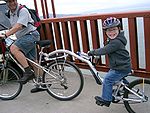
Bicycles can be categorized in different ways: e.g. by function, by number of riders, by general construction, by gearing or by means of propulsion. The common types include utility bicycles, mountain bicycles, racing bicycles, touring bicycles, cruiser bicycles, and BMX bicycles. Less common types include tandems, recumbents, lowriders, tall bikes, fixed gear, and folding models. Unicycles, tricycles and quadracycles are not strictly bicycles, as they have respectively one, three and four wheels, but are often referred to informally as "bikes".
See also
- Cycling - use of bicycles
- List of bicyclists
General
- Bicycle industry and List of bicycle manufacturing companies
- Bicycle lighting
- Bicycle lock
- Bicycle parts
- Bicycle tools
- Full fairing - covering canopies for bicycles
- Trampe bicycle lift
Special uses and related vehicle types
- Balance bicycle
- Bicycle trailer
- Boda-boda
- Cycle rickshaw
- Freight bicycle
- Quadricycle
- Shaft-driven bicycle
- Tandem bicycle
- Trailer bike
- Tricycle
- Utility cycling
- Velocipede
- Workbike
Other
- Human-powered transport
- Environment topics, list of
- Safety standards
- Transportation technology, timeline of
Notes
- ^ DidYouKnow.cd. There are about a billion bicycles in the world. Retrieved 30 July 2006.
- ^ Herlihy, David V. (2004). Bicycle: the history. Yale University Press. pp. 200–250. ISBN 0-300-10418-9.
- ^ "Canada Science and Technology Museum: Baron von Drais' Bicycle". 2006. Retrieved 2006-12-23.
- ^ a b Bluejay, Michael. "Safety Accessories". Bicycle Accessories. BicycleUniverse.info. Retrieved 2006-09-13.
- ^ "The Essentials of Bike Clothing". About Bicycling. About.com. Retrieved 2006-09-13.
- ^ "Bicycle Technology", S.S. Wilson, Scientific American, March 1973
- ^ "Johns Hopkins Gazette", 30 August 1999
- ^ Whitt, Frank R. (1982). Bicycling Science (Second edition ed.). Massachusetts Institute of Technology. pp. 277–300. ISBN 0-262-23111-5.
{{cite book}}:|edition=has extra text (help); Unknown parameter|coauthors=ignored (|author=suggested) (help) - ^ http://www.kenkifer.com/bikepages/advocacy/bike_co2.htm
- ^ "The Wrights' bicycle shop". 2007. Retrieved 2007-02-05.
- ^ The Economist, 15 February 2003
- ^ http://www.newn.cam.ac.uk/about/about_history2.shtml
References
- All About Bicycling, Rand McNally.
- Richard Ballantine, Richard's Bicycle Book, Pan, 1975.
- Caunter C. F. The History and Development of Cycles Science Museum London 1972.
- Daniel Kirshner. Some nonexplanations of bicycle stability. American Journal of Physics, 48(1), 1980. The abstract reads "In this paper we attempt to verify a nongyroscopic theory of bicycle stability, and fail".
- David B. Perry, Bike Cult: the Ultimate Guide to Human-powered Vehicles, Four Walls Eight Windows, 1995.
- Roni Sarig, The Everything Bicycle Book, Adams Media Corporation, 1997
- "Randonneurs USA". PBP: Paris-Brest-Paris. March 31.
{{cite web}}: Check date values in:|date=and|year=/|date=mismatch (help) - US Department of Transportation, Federal Highway Administration. "America's Highways 1776-1976", pp. 42-43. Washington, DC, US Government Printing Office.
- David Gordon Wilson, Bicycling Science, MIT press, ISBN 0-262-73154-1
- David V. Herlihy, Bicycle: The History, Yale University Press, 2004
- Frank Berto, The Dancing Chain: History and Development of the Derailleur Bicycle, San Francisco: Van der Plas Publications, 2005, ISBN 1-892495-41-4.
- The Data Book: 100 Years of Bicycle Component and Accessory Design, San Francisco: Van der Plas Publications, 2005, ISBN 1-892495-01-5.
- "Bicycle facts". Retrieved 2006-07-25.
External links
- A range of Traffic Advisory Leaflets produced by the UK Department for Transport covering cycling.
- Menotomy Vintage Bicycles - Databases of antique bicycle photos, features, price guide and research tools. Very large archives.
- The Bicycle - Worlds most efficient form of transportation Discussion of the Bicycle and its advantages over motor vehicles
- Brown, Sheldon (2005). Extensive Online Bicycle Glossary
- Hudson, William (2003). Myths and Milestones in Bicycle Evolution. Retrieved March 30 2005.
- A History of Bicycles and Other Cycles at the Canada Science and Technology Museum
- Jones, David E. H. (1970). The Stability of the Bicycle. Scanned in copy for download for personal use.
- Sustrans
